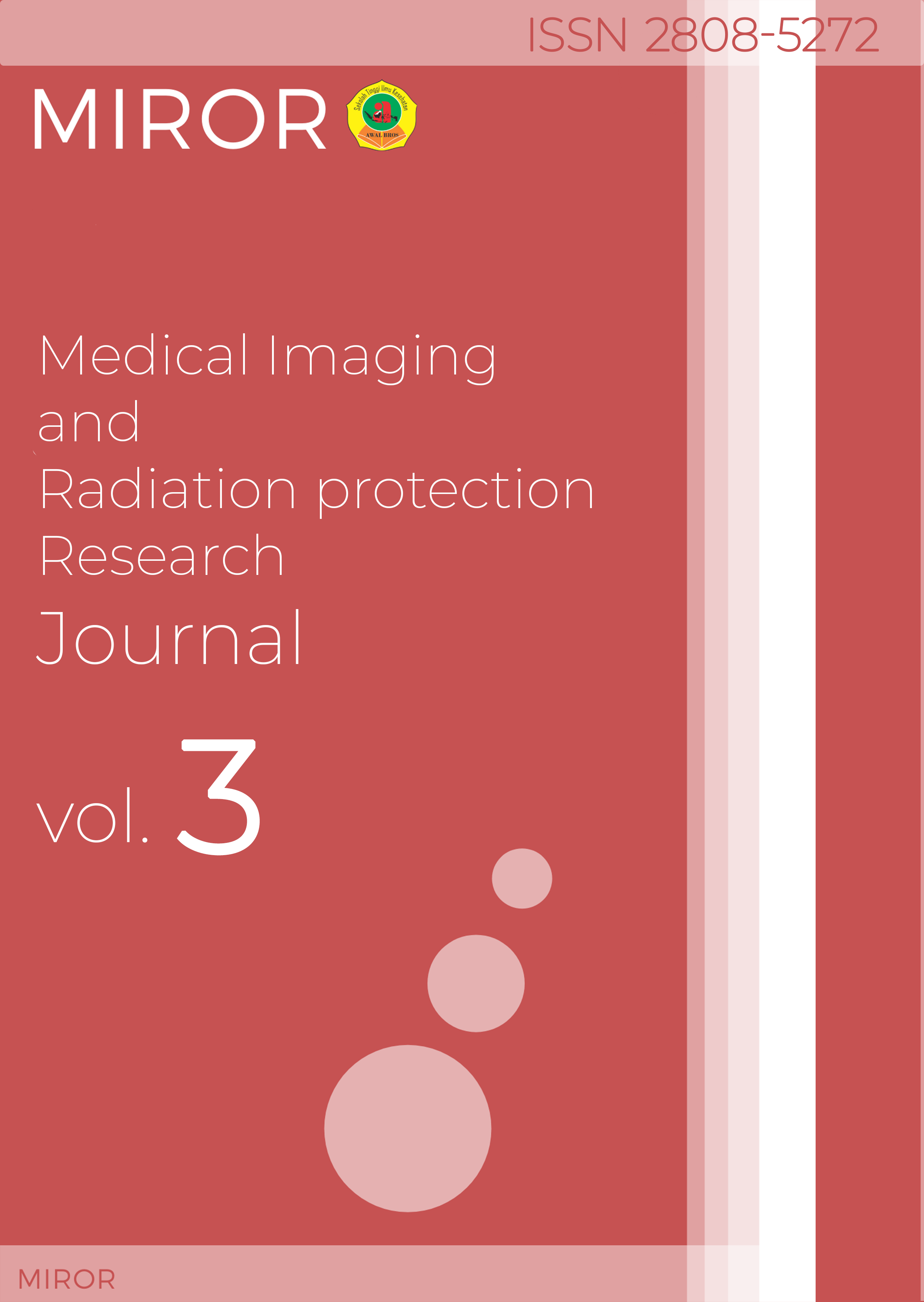ANALYSIS OF VARIATION OF USING SLICE THICKNESS ON IMAGE QUALITY IN CORONAL PARAASAL SINUS CT SCAN EXAMINATION USING SINUSITIS CLINICAL AT LEVEL II HOSPITAL PELAMONIA MAKASSAR
DOI:
https://doi.org/10.54973/miror.v3i2.264Abstract
Sinusitis is a bacterial infectious disease that patients often complain about to doctors in the ears, nose and throat (ENT). A CT scan is an examination of the choice to see the paranasal sinuses in the axial, sagittal and coronal fields. On the coronal field it is good to display osteomeatal complexes and more informative than axial and sagittal pieces. CT scans have components that affect image quality consisting of spatial resolution, contrast resolution, and noise. Spatial resolution is the ability of a system to distinguish a structure from a very small object with a very adjacent location. Contrast resolution is the ability to distinguish the density or density of the structure of a particular object adjacent to each other. Noise is the standard percentage deviation from the number of pixel values obtained from the result of waterbath imagery. This type of research is quantitative with an experimental approach to analyze the use of slice thickness variations on image quality using variations: 0.5 mm, 1 mm, 1.5 mm, 2 mm, 2.5 mm, and 3 mm. Data collection was carried out in June - July 2022 with 10 samples. Researchers took data on the examination of CT Scans of the paranasal sinuses with clinical sinusitis. With the results of the research conducted, it can be concluded that in the overall friedman test results there is an influence on the use of slice thickness variations on image quality in the paranasal sinus CT scan examination with clinical sinusitis using slice thickness variations. Based on the results of this study, researchers can recommend a paranasal sinus CT scan with clinical sinusitis using a slice thickness of 0.5 mm to get good and optimal image quality results.
Downloads
References
Abayomi OE, Michael AO, Jerry EC, Moses AA. Diagnostic Reference Level in Computed Tomography : An Evaluation of CT-Protocol Dose Index in a Diagnostic Facility. 2018;1(1).
Ahadiyah NN, Setiawati E, Arifin Z, Anam C. Pengukuran Computed Tomography Dose Index (Ctdi) Pada Fantom Kepala Dengan Menggunakan Ct Dose Profiler. Berk Fis. 2020;23(4):118-125.
Badan K, Tenaga P. Peraturan Kepala Badan Pengawas Tenaga Nuklir Nomor 8 Tahun 2011. Published online 2011.
Chuang CC, Wu J. Dose and slice thickness evaluation with nMAG gel dosimeters in computed tomography. Sci Rep. 2018;8(1):1-7.
Geise RA. Computed Tomography: Physical Principles, Clinical Applications, and Quality Control. Vol 194.; 1995.
Irsal M, Winarno G. Pengaruh Parameter Milliampere-Second (mAs) terhadap Kualitas Citra Dan Dosis Radiasi Pada Pemeriksaan CT scan Kepala Pediatrik. J Fis Flux J Ilm Fis FMIPA Univ Lambung Mangkurat. 2020;17(1):1.
R. Haaga John 2017. CT AND MRI OF THE WHOLE BODY, SIXTH EDITION : Elsevier, Inc.
Reith W. Computed Tomography.; 2016. doi:10.1007/978-3-662-44037-7_4
Romans 2011. Computed Tomography For Technologist a Comprehensive Text. Philadelphia : Wolters Kluwer Health.
Sari DA, Setiawati E, Arifin Z, Fisika D, Sains F, Diponegoro U. Analisis Nilai Computed Tomography Dose Index ( Ctdi ) Phantom Kepala Menggunakan Ct Dose Profiler Dengan Variasi Pitch. Berk Fis. 2020;23(2):42-48.
Saputri LD, Santoso B, Oktavianto AN, Anita F. Analisis Dosis Serap CT Scan Thorax Dengan Computed Tomography Dose Index Dan Thermoluminescence Dosimeter. J Ilm Giga. 2019;20(1):10.
Downloads
Published
How to Cite
Issue
Section
License
Copyright (c) 2024 Muh. Anjas Irawan Hamzah Anjas, Ni Putu Rita Jeniyanthi Rita, Made Sayang Pratista Sayang

This work is licensed under a Creative Commons Attribution-NonCommercial 4.0 International License.


